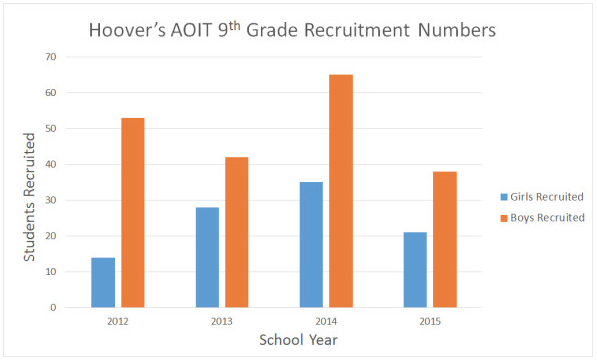At Hoover High School’s Academy of Information Technology, students learn an array of technical skills from website design and coding to software and systems development.
Ellen Towers, a teacher who left a career at General Motors, launched AOIT at the school in 2003. The academy has more than 500 graduates.
But there’s a problem. Far fewer girls than boys enroll.
I went to Hoover to find out why.
Here are Hoover’s AOIT ninth grade recruitment numbers, the students signing up for the academy once they enter high school:
A few weeks ago, I asked academy students and staff about the gender gap. It seemed what happened off campus influenced students’ choices to enroll in the academy.
I asked boys if they feel more encouraged than girls to explore IT-related careers. Some boys said girls get equal encouragement. But others said boys get a boost in the tech industry.
“Yes, male future IT [workers] get more of an advantage on getting jobs” in the field than women, Manuel Echevarria, a sophomore, wrote in an AOIT student survey.
Lewis Chho, a sophomore, doesn’t feel any more encouraged than girls, but he wrote, “I’m sure there is still some amount of sexism or bias that puts women at a disadvantage when it comes to the industry.”
Many students said they associated technology with images of men: Bill Gates, Steve Jobs and Mark Zuckerberg.
I asked girls if they received encouragement from their families to join the academy. Some said they did. Others described mediocre family support.
“Yeah, for them it wasn’t a big deal,” Vanessa Sanchez, a sophomore, wrote.
“They don’t care and they’re happy as long as I’m good and happy with what I pick,” Lar Meh, a sophomore, wrote.
Sonia Pelayo, a senior planning to major in computer science, said she chose the tech academy. Her father was against it but her mother supported her.
It became clear boys and girls received different messages.
Hoover, of course, is not an outlier. The disproportionate involvement of men in technology stretches to the top of the industry.
In 2014, only 16 percent of Microsoft’s technical positions were held by women, according to CNET. Twitter’s technical workforce was 10 percent women, and Google’s was 17 percent women.
Women make up about 59 percent of the U.S. labor force and 51 percent of the entire U.S. population, according to the Census Bureau.
By 2020, there will be 1 million more computer science-related jobs than qualified graduating students, according to the Bureau of Labor Statistics.
For women to fill a significant part of those roles, something will have to change.
And funding is pouring in to find a solution.
In 2009, President Obama launched a $4.35 billion Race to the Top competition to encourage states to promote so-called STEM (Science Technology Engineering and Mathematics) programs and – among other goals – increase the amount of women and girls who participate.
Even tech companies are making commitments.
Just a year ago, Intel pledged $300 million toward STEM education to increase the numbers of minorities and women in startup companies.
And Apple – with only 20 percent of their tech positions held by women – pledged $10 million to the National Center for Women and Information Technology. Lucy Sanders, NCWIT’s CEO and co-founder wants to engage 10,000 middle school girls in tech workshops over four years.
Hoover’s AOIT staff partnered with companies like Solar Turbines, Booz Allen Hamilton, Qualcomm, The College and Career Technical Education, SDSU and others to provide professional development support for students. Some, like The Control Group, help host girls-only tech-themed field trips.
The staff also emphasize on-campus support for girls.
“Once female students get into our program, they are hooked, they are naturals with IT. The trick is to get girls to see themselves as ‘techie,’” Angela Hummel, former AOIT director and advisory board facilitator, wrote in an email.
Hummel helps provide students with opportunities to meet with women in technology.
“Our teachers in AOIT model this very well, and are great examples of women with sophisticated IT know-how. That’s the kind of influence and support that really matters,” she said.
Students say the academy provides equal support regardless of gender. Even some boys feel a responsibility to encourage more girls to join AOIT.
“I tell girls that it is fun and that it is a useful skill to use in life,” Solis Herberth, a sophomore, wrote.
And though the academy’s students feel a sense of equality on campus, girls said families can motivate more girls to pursue IT careers, too.
Marina Valle, a sophomore, wrote families can “tell them how not many girls are involved in IT careers and they should change that to not let boys take all the credit … we can do anything a man is capable of.”


